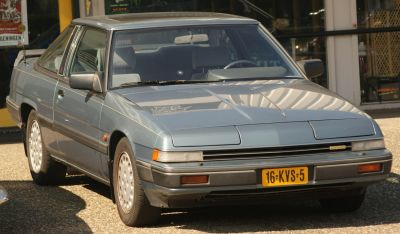 1979 Toyota Celica Supra I (A40/A50) Dimensions, Size & Specs
1979 Toyota Celica Supra I (A40/A50) Dimensions, Size & SpecsMeasurements of the 1979 Toyota Celica Supra I, engineered for optimal performance and comfort
| Dimensions | |
|---|---|
| Length: | 4615 mm181.7 in15.1 ft |
| Width: | 1651 mm65.0 in5.4 ft |
| Height: | 1316 mm51.8 in4.3 ft |
| Trunk Capacity (Max): | 688 liter24.3 cu ft |
| Weight Specifications | |
| Curb Weight: | 1300 kg2866 lbs |
| Tire Specifications | |
| Tire Size: |
|
The 1979 Toyota Celica Supra I (A40/A50) marks the first generation of Toyota's Supra lineage, produced between 1979 and 1981. This compact sports coupe combines a sleek and sporty design with practical dimensions, positioning it as a standout vehicle in the late 1970s Japanese sports coupe market. Measuring 4615 mm (181.5 inches) in length, 1651 mm (65 inches) in width, and 1316 mm (51.8 inches) in height, the Celica Supra I delivers a low and streamlined profile conducive to both aerodynamics and an assertive road presence. Weighing in at a curb weight of 1300 kg (2866 lbs), it balances agility with stability, offering drivers a dynamic driving experience. Inside, the coupe provides notable practicality for its class with a generous luggage capacity of 688 liters when the rear seats are folded down, making it suitable for both sporty outings and modest cargo needs. The car rolls on 195/70 R14 tires, contributing to its balanced handling and ride comfort. Overall, the 1979 Toyota Celica Supra I (A40/A50) coupe is a well-proportioned vehicle that embodies the early Supra spirit—compact yet engaging, blending sporty charm with everyday usability.
Discover the standout features that make the 1979 Toyota Celica Supra I a leader in its class
Have a question? Please check our knowledgebase first.
The Toyota Celica Supra I (A40/A50), produced from 1979 to 1981, has a length of 4615 mm (181.5 inches), a width of 1651 mm (65 inches), and a height of 1316 mm (51.8 inches). These compact coupe dimensions contributed to its sporty appearance and driving dynamics during its era.
The curb weight of the Toyota Celica Supra I is approximately 1300 kg (2866 lbs). This relatively light weight helps the car deliver nimble handling and improved acceleration, which are important qualities for a sporty coupe designed to offer an engaging driving experience.
With the rear seats folded, the Toyota Celica Supra I offers a generous luggage capacity of 688 liters (24.3 cubic feet). This spacious cargo area was quite practical for a coupe of its time, allowing owners to carry larger items despite the car's sporty focus.
The Toyota Celica Supra I is equipped with 195/70 R14 tires. These tires balance comfort and performance, providing good grip and ride quality for a sporty car in the late 1970s and early 1980s. The tire size supports stable cornering and responsive handling.
Yes, the Toyota Celica Supra I’s dimensions—4615 mm in length, 1651 mm in width, and 1316 mm in height—make it suitable to fit comfortably inside a standard garage. Most residential garages are built to accommodate vehicles wider and longer than this model, so parking the Celica Supra I is generally hassle-free.
The Celica Supra I was essentially a more powerful and slightly larger derivative of the Toyota Celica of that era, with increased length and curb weight due to its bigger inline-six engines and added luxury features. While sharing the Celica's sporty coupe styling, the Supra I was designed to be a more premium and performance-focused model, so its dimensions reflect an evolution toward a grand touring coupe rather than a pure sports car.
The Celica Supra I’s size puts it within the typical range for grand touring coupes of its time. For example, it is similar in length and width to European sports coupes like the BMW E21 3 Series coupe and slightly larger than nimble Japanese coupes such as the Datsun 280ZX. Its balance of compact dimensions and interior space was competitive, offering both sporty handling and practical usability.
Despite its relatively compact exterior size, the Celica Supra I provides reasonable interior space for front occupants, typical of a 2+2 coupe configuration. However, rear passenger space is limited, which is common for sporty coupes, but the ability to fold down rear seats to increase cargo capacity enhances its practicality. The low height of 1316 mm (51.8 inches) helps provide a sporty driving position but may limit headroom for taller passengers.
The Supra I's relatively narrow width of 1651 mm (65 inches) makes it well-suited for maneuvering through tight city streets, narrow parking spaces, and heavy traffic. This dimension is narrower than many modern vehicles, offering an advantage in urban driving conditions, while still allowing sufficient cabin width for comfortable seating.
The Celica Supra I stands out with its distinctive long hood and hatchback coupe styling, signaling its performance ambitions. It featured a robust inline-six engine lineup, offering more power than its Celica counterpart, and had upgraded suspension and brakes. These features, combined with improved interior appointments, positioned it as Toyota’s early entry into the sports luxury segment before evolving into the iconic Supra lineage.
Discover similar sized cars.

| Production: | 1982-1987 |
|---|---|
| Model Year: | 1982 |
| Length: | 4640 mm182.7 in |
| Width: | 1690 mm66.5 in |
| Height: | 1355 mm53.3 in |
